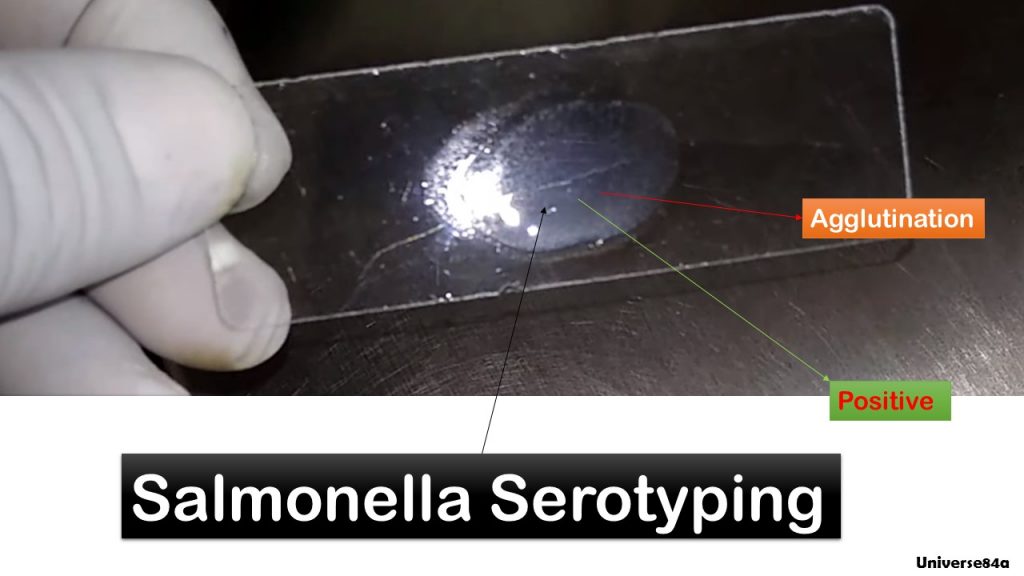Salmonella Serotyping: Introduction, Principle, Requirements, Test Procedure, Result Interpretation and Keynotes

Introduction of Salmonella Serotyping
Salmonella Serotyping helps to differentiate serotypes of Salmonella. Serotypes refer to separate groups within a species of microorganisms that all share a similar property. More specifically, each serotype has the same number of antigens on its surfaces. For example, Salmonella enterica serotype Typhi and Salmonella enterica serotype Paratyphi. Serotypes are differentiated on the basis of agglutination tests and used to help with the identification of Salmonella, Shigella, Vibrio cholerae, Haemophilus influenzae, etc.
Principle of Salmonella Serotyping
Salmonella Serotyping works on the principle of agglutination. When a particulate antigen (agglutinogen) combines with its antibody (agglutinin) in the presence of electrolytes at a suitable temperature and pH, the particles are clumped or agglutinated. Agglutination is the aggregation of already insoluble particles or cells into larger clumps. Interaction between the antibody (Ab) and particulate antigen results in visible clumping called agglutination.
Test Requirements for Salmonella Serotyping
Salmonella serotyping needs the following requirements-
- Test organism ( pure colony)
- Antisera (serotypes)
- Sterile, clean, and grease-free glass slides
- Normal saline
- Inoculating loop/ Sterile mixing sticks
- Bunsen burner
- Gloves
- Waste bin
- Control strains
Test Procedure of Salmonella Serotyping
(Slide agglutination of live organisms)
- All materials have to be at room temperature at the time of testing.
- Dispense two 5-10µl volumes of sterile 0.85% saline solution(saline) onto a carefully cleaned microscope slide. The slide may be partitioned using a chinagraph pencil. With a platinum wire of disposable inoculation loop take one 1-2 colony of live organisms from a fresh culture on nutrient agar or similar and emulsify into each drop of saline to produce distinct and uniform turbidity.
- Place a drop (30-40 µl ) of antiserum onto one of the emulsified isolates and onto the other a drop (30-40 µl ) of saline as a control. Note: do not allow the organism to contaminate the antiserum dropper bottle.
- Mix the reagent by tilting the slide back and forth for 60 seconds while viewing under indirect light against a dark background.
- distinct clumping or agglutination within this period, without clumping in the saline control (auto-agglutination), should be regarded as a positive result. Weak agglutination should record as negative.
Slide agglutination of heat-treated organisms
If no agglutination is found with any of the polyvalent O sera, repeat the above procedure using the Vi antiserum. If positive agglutination is found with a Vi antiserum, prepare a dense cell suspension of the organism in saline and heat it to 100 °C for one hour or autoclave at 121°C for 15 minutes. Repeat the slide agglutination tests as described above with polyvalent O and Vi antisera. The Vi antiserum should now give a negative result and the O antigen should be revealed.
Resul and Interpretation of Salmonella Serotyping
Isolates producing a distinct positive reaction with a polyvalent antiserum are assumed to be Salmonella from the group (O or H) represented by the antiserum. Further testing of the isolate should be conducted as described in steps 1-3 with monovalent antiserum.
Quality Control (QC): It is recommended that quality control should be performed with at least one organism to demonstrate a positive reaction and at least one organism to demonstrate a negative reaction. Do not use the product if the reactions with the control organisms are incorrect. Check for signs of deterioration. Do not use reagents if they are contaminated or cloudy.
Salmonella Typhi: Polyvalent O, Polyvalent H, O9, Hd and Vi. At least three shall give positive agglutination.
Salmonella Paratyphi A: Polyvalent O, Polyvalent H, O2 and Ha. At least three shall give positive agglutination.
Keynotes on Salmonella Serotyping
- Salmonella, Shigella, Vibrio cholerae, and Haemophilus influenzae are the most common bacteria in those serotyping is performed.
- Serotyping works on the principle of agglutination.
- Only do agglutination on pure colonies, which biochemically are the suspected organism. If the specimen consists of multiple strains, the serotype may not be correctly identified.
- Nutrient agar is best for the agglutination tests.
- Serotyping is recommended from non-selective media as MHA, Blood agar, or TSI.
Further Readings on Salmonella Serotyping
- https://assets.publishing.service.gov.uk/government/uploads/system/uploads/attachment_data/file/762019/TP_3i4.pdf
- https://www.frontiersin.org/articles/10.3389/fmicb.2019.02554/full
- https://www.oie.int/fileadmin/Home/eng/Our_scientific_expertise/docs/pdf/Usermanual_CTS_Feb12.pdf
- https://800ezmicro.com/supplies/pathogen-id-kits/57-salmonella-latex-agglutination-kit.html
- https://mast-group.com/uk/products/id-and-detection/mast-assure-salmonella-agglutinating-antisera/
- https://catalog.hardydiagnostics.com/cp_prod/product/m10345-mastassure-bacterial-agglutinating-antisera-2ml-salmonella-h-factor-5-order-by-the-each-by-mast-group-antisera
